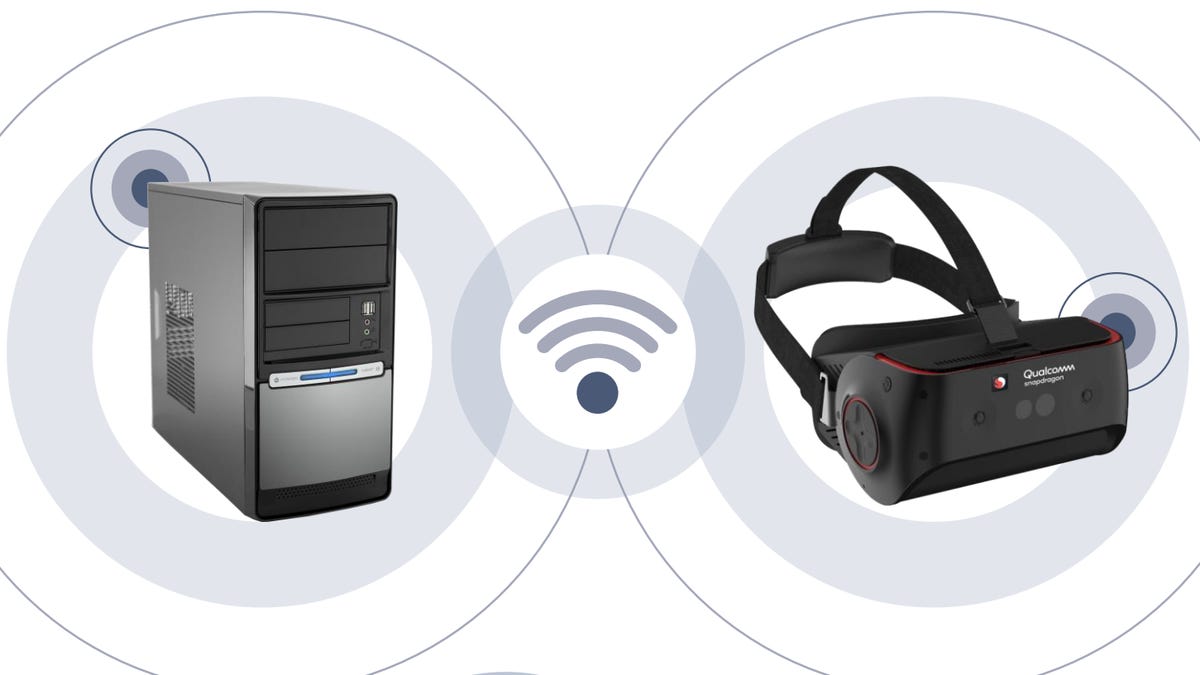Qualcomm's new wireless VR headsets work with PCs, too
Exclusive: New Snapdragon-powered VR and AR headsets will double as wireless VR for PCs starting this year. Is this the future of Oculus, Vive and even HoloLens?

There are just too many VR helmets and goggles out there -- getting even one on your face is enough of a struggle. But Qualcomm's new vision for its next generation of standalone VR headsets has a solution to that problem.
Qualcomm is developing VR headsets that will work as wireless PC-connected, head-mounted displays. Hardware will start arriving later this year, according to Qualcomm, and it'll be available for demo at this year's Game Developers Conference in San Francisco.
The new initiative, called "Boundless XR for PC," uses Qualcomm's Snapdragon 845 processor combined with a wireless 802.11ad chip that will allow high-bandwidth 60GHz connections to a PC or console that's ready to communicate with it. The VR headset will be a standalone device, like the upcoming Oculus Quest, but when it's near a PC, it'll double as a wireless way to play PC games and apps. And it could even hint at where AR headsets such as the HoloLens 2 will head next. Qualcomm's Hugo Swart explained how it works in a conversation with CNET ahead of GDC.
Like a future Oculus Quest that works with your PC
At last year's GDC, Qualcomm showed off a next-generation standalone VR headset using a Snapdragon 845 chip and eye tracking. This year's headset design takes the same chip and adds 802.11ad wireless 60GHz connection, so it can wirelessly connect with a PC and act as its VR headset, too. The wireless connection will have 16ms latency, according to Qualcomm.
The PC streams low-latency graphics and game content to the headset, which sends its built-in six degrees of freedom room tracking back to the PC. It's similar to the way HTC Vive's wireless PC headset already works. What's most interesting here, though, is that the VR headset and PC will split processing.
Since VR processing will be handled by the PC and the headset's Snapdragon 845 chip, according to Swart, this means PCs could run VR off lower-end CPUs (but the onboard PC graphics would likely need to be the same). PCs or consoles would need 802.11ad Wi-Fi, and also run Qualcomm software that enables this communication and processing with these upcoming headsets. According to Qualcomm, PC content and games won't need any alteration at all.
A preview of how 5G VR will work?
Swart explains the initiative as a stepping stone to eventually having one headset that does both AR and VR, local and wirelessly over 5G. We're not there yet, but these headsets will connect to PCs in a similar way to how they may connect over 5G in the future.
That same split processing is what Qualcomm envisions in future 5G-enabled hardware, mixing some rendering in the cloud and some in-headset. While these headsets are designed to connect to PCs and local devices, eventually they could mix sources from the 5G cloud, local devices and more.
The first VR headset with 802.11ad will be the Pico Neo2.
One hardware device so far
We don't know where else this technology will appear, but expect headsets to start arriving this year, according to Qualcomm's Swart. First up is a Pico Neo2 VR headset that will be "Boundless XR for PC" compatible and have a Snapdragon 845 chip.
While the idea of "Boundless for XR" imagines AR and VR devices with wireless tethering, Swart admits that for now, VR headsets will be the major focus, with AR (mixed reality) coming further down the road. Future Snapdragon-enabled AR headsets, such as nReal's compact glasses, could be possible candidates.
The Vive Cosmos, teased at CES in January, remains a mystery but promises similar ideas.
Is this what Vive Cosmos is?
Qualcomm's partners so far include software partners Framestore and ZeroLight, hardware partners Pico, Goertek and WNC, and... HTC Vive. Which raises the question: Is this a preview of what the mysterious, multi-connectable Vive Cosmos will be?
Qualcomm won't say, and HTC hasn't confirmed anything yet. But if this means premium standalone headsets could also connect to PCs wirelessly, then maybe this is what the next generation of VR and AR will look like. This would make sense for the next Microsoft HoloLens (which also runs off a Qualcomm chip) as much as the next Oculus Rift or Vive.
Qualcomm's reference designs have been a pretty good predictor of the future: The company's standalone Snapdragon 820 headset preceded the Oculus Go. Its Snapdragon 835 standalone reference led to the Lenovo Mirage Solo, HTC Vive Focus and Oculus Quest.
Qualcomm already has a parallel vision of the future of AR and VR at Mobile World Congress in Barcelona, with compact, possibly low-cost VR and AR headsets that will plug into 5G phones via USB-C. These newly announced PC-connected standalone wireless headsets look to be larger and more expensive than those USB-C plug-in possibilities. But it suggests that a lot of convergence is on the way for VR and AR in the next few years.
CNET will be demoing the tech from GDC, so stay tuned for impressions to come.

